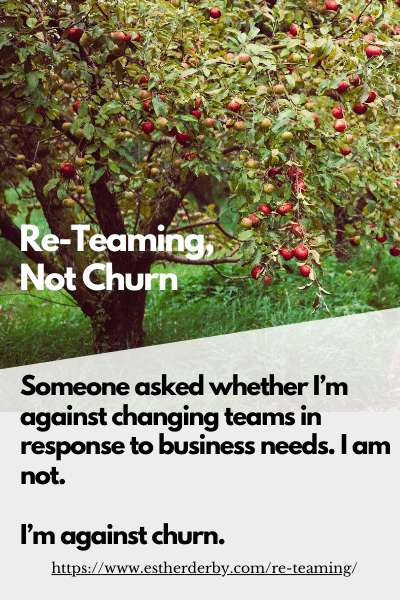I was talking to my friend Penny the other day about a team she coaches. She has a problem I’ve seen on many teams: a smart guy (or gal) who dominates the team.
I’ll call Penny’s team member Bob. Most of the time Bob is an asset to the team. But when the team needs to decide on a technical solution under time pressure, he’s not.
How can this be?
Dominating the Flow of Ideas
When it comes time to solve a technical problem, Bob always offers his idea first. Then, Bob dominates the conversation with a constant stream of words, leaving no opening for another to insert facts, ideas, points of view. When someone speaks up, Bob cuts him off.
When Bob finishes, and another team members asks a question, Bob implies that the other person doesn’t understand. He even hints they might be too stupid to see the brilliance of his ideas.
When another team member proposes a different idea, Bob shreds it. He points out the flaws in the other person’s idea, while pointing to the strengths of his own idea.
When he does let others speak, it’s pretty clear that he isn’t listening to learn. Bob is figuring out how to score his next point.
How a Dominant Person Can Hurt a Team
I don’t believe Bob has bad intentions. I believe he wants to be helpful, and believes he is. Bob is helping the team in many ways, but he’s also hurting the team. Here’s how:
1. The team don’t have enough ideas. Due to Bob’s style, there is seldom more than one idea (Bob’s) that receives serious consideration. That’s not enough. Even if Bob is smart, so are the other people on the team. But Bob is a fast thinker. He’s the best at argument and debate. However, that’s not the same as having the best ideas.
2. Over time, Bob’s style will wear down the other team members. It’s really not terribly satisfying to be browbeaten. At some point, other people will stop offering ideas. They’ll acquiesce rather than endure another argument with Bob.
3. As long as Bob’s ideas prevail, others don’t have a chance to develop their ideas.They are deprived the opportunity to learn, think about problems and risks, and increase their capability. Over the long run, that’s bad for the individuals involved, bad for the team, bad for the organization. Teams do better when participation is roughly equal.
Make it Easier for All to Raise Ideas
Penny has given Bob feedback on the effects of his behavior. For a short time, Bob altered his behavior. But when there’s pressure to come up with a solution, Bob falls back on his old behavior. Chances are, Penny won’t get Bob to change that. Bob’s is acting out of his natural tendencies. Furthermore, he believes that competition and argument forge the best ideas.
However, Penny can change the process so that the team has sufficient ideas to consider, and that credible ideas receive due consideration.
Here’s how:
Separate generating ideas, explaining ideas, exploring ideas, and evaluating ideas. Up until now, these distinct processes overlap and slosh together (with Bob center stage).
Equalize participation. From what Penny has told me, I suspect Bob is a strong extravert and the other team members are introverts. That means that Bob is very comfortable thinking out loud, and the other team members need a bit of time to organize their thoughts. Before they have time to do that, Bob is on a roll. One way make room for more participation is to start the process with a few minutes of silent brainstorming. Then, ask each person explain (orally or through sketching) the essentials of his or her best idea.
Apply the Rule of Three. If you don’t have at least three ideas, you don’t have enough ideas, and you probably don’t understand the problem. You may end up with deciding the first idea that came up is the best one…but you may not, or you may refine the first idea based on further discussion.
Test for agreement. Some teams get carried away with voting. But when a decisions are routinely highjacked by one individual, it can help to test for agreement using a gradient of agreement or fist of five.
Establish a small set of tests for technical solutions. In this team, some of the tests that make sense might be:
The solution …
- is the simplest thing that can work.
- doesn’t increase technical debt.
- can be implemented in the timeframe required by service level agreements.
Bob may have the best ideas on the team. We don’t really know if that’s the case. No one else’s ideas receive full consideration. We do know he doesn’t have a perfect record. Some of his fixes don’t work the first time. Some of his fixes break something else. If the team had a process to consider and refine ideas, that might not happen as much.
It may sound like it will take more time to separate generating ideas from explaining, exploring, and evaluating them. It may seem like a lot of effort to find more than one idea and test the ideas for soundness and test the level of support for a given idea.
But in years of observing teams, I find that slowing down and separating the steps of the choosing a solution helps the team speed up. A mashup process forced by a dominant individual may appear to save time in the very short-term. That’s seldom true if you account for all the time costs and other effects incurred.








Great Post! Sorry, but this awakened my inner-academic geek 😉
There’s quite a bit of academic literature that supports your post: That is, expanding the knowledge pool improves the result of group decision-making (Dunbar, 1995) and the group size or, in particular, how much time opportunity is given to people in the group to express their ideas (Fay et al, 2000).
Dunbar, K. (1995). How scientists really reason: Scientific reasoning in real-world laboratories. In R.J. Sternberg, & J. Davidson (Eds.). Mechanisms of insight. Cambridge MA: MIT press. pp 365-395
Fay, N.; Garrod, S. & Carletta, J. Group Discussion as Interactive Dialogue or as Serial Monologue: The Influence of Group Size Psychological Science, 2000, 11, 481-486(6)
— Dan =)
Thanks for the references!
Bob sounds like a couple of Test Consultants I know. They both vehemetly prescribe their school and methodology and then beat you into submission if you don’t agree with them. And even when you do submit they still treat you with disdain.
Smart people with good ideas at times tend to shoot themselves in the leg (which then richocet’s off at others in the room) by being too insistent that they are right and the only one who is right. In the long run they do damage to their credibility and eventually no one listens to them even if they have a great idea. Too smart for their own good.
Actually, this is all Penny’s fault for not being a better manager and creating a better forum for her team.
Why is it Penny’s fault? Bob is the one who is domineering.
For that matter, why is it anyone’s fault?
This is a very common problem on teams. In part, it is due to the pervasive believe that smart talk is equivalent to intelligence. In part, it’s due to how western culture views argument as a battle to be won, rather than a chance to learn.
Penny is an agile coach. Her role is primarily to help the team with agile engineering practices. Like most people in our field, her university work didn’t include the study of group dynamics and facilitation.
She’s come across a problem she didn’t know how to solve, so she asked for help.
Seems pretty smart to me.
I think Bob isnt exactly extrovert, he has glory issue.Extrovert dont exactly push for ideas or try to dominate,they share their thoughts.Extroverts talk fearlessly within their boundaries.I remember this has also been proved scientifically.Sorry I dont recollect the link, but here is the site http://www.psychologytoday.com where I might have seen it.
Hi, Kiran-
I’m not sure I know what a “glory issue” is. Based on what Penny told me I am pretty sure he’s an Extravert in Myers-Briggs terms.
I know many Extraverts who are unaware of the effect they have on a group of Introverts. (And many introverts who don’t understand the effect they have on Extraverts.)
In any case, I suspect that if it is a “glory issue”, it’s both/and, not either/or.
Thanks for stopping by and commenting.
e
Interesting post. I think another solution would be to have Bob work with other Bob-type people, or people more introvert but better than him if you can find them.
Actually, I would say large, ambitious projects led by Bob-s tend to be more successful. A very famous Bob’s actual first name is Linus; he says that he has “strong opinions”. Steve Jobs was a Bob, Jeff Bezos is probably a Bob… you get the idea.
In my experience Bob-s are able to recognize when their ideas fail; they endorse the responsibility and hate themselves for it. Then they remember early criticism and solutions they dismissed, and the people did that earn their respect. And Bob-s listen to people they respect.
I think “Bob-ness” is acquired, not natural: Bob-s are made, not born. They are people who at some point in their lives have been regularly the brightest in the room, been dismissed, seen other ideas be adopted and fail. Then *they blame themselves* for not having fought enough. Thing Roger Boisjoly (http://en.wikipedia.org/wiki/Roger_Boisjoly)…
I like Bob-s. I think they’re passionate people. A little too passionate, but at least odds are that they care about the team / project’s success more than personal goals.
(Oh, and by the way, maybe it’s obvious but I’d better precise it: I have seen female Bob-s too. You could invert the names Penny and Bob and the story would still work for me.)
Hi, Pierre –
You have described a subset of “Bobs” who have both great ideas and the ability to reflect and take responsibility for their failed ideas.
But many “Bobs” are neither brilliant nor able to reflect and take responsibility. The fact of those exceptions isn’t enough to justify all the other “Bobs”—who are not brilliant and don’t see or learn from the consequences of their bad ideas. Those “Bobs” run rough shod over their team mates, wear people down, and often make more work for other people.
If someone’s ideas actually are exceptional, they will shine through–as long as they aren’t quashed by a domineering team member.
(I have also met female “Bobs.”)
e
As a Scrum Master I recognize “Bob” is a (team) member in each of my projects … 😉
CU
Boeffi
We’ve had a Bob in our team – and finally we decided to dismiss him. Now the team has a chance to improve.
Maybe you could look at some principles of decision making in sociocracy. I’m sure you will find them very well explained with a small search on the web, but rapidly, when you have to make a decision, everybody around the table have some time to speak, each in turn. you cannot have ping pong discussion. there are some other mechanism interesting to it, but even just that could be a wonderful start.
An alternative solution. http://en.wikipedia.org/wiki/Shock_collar